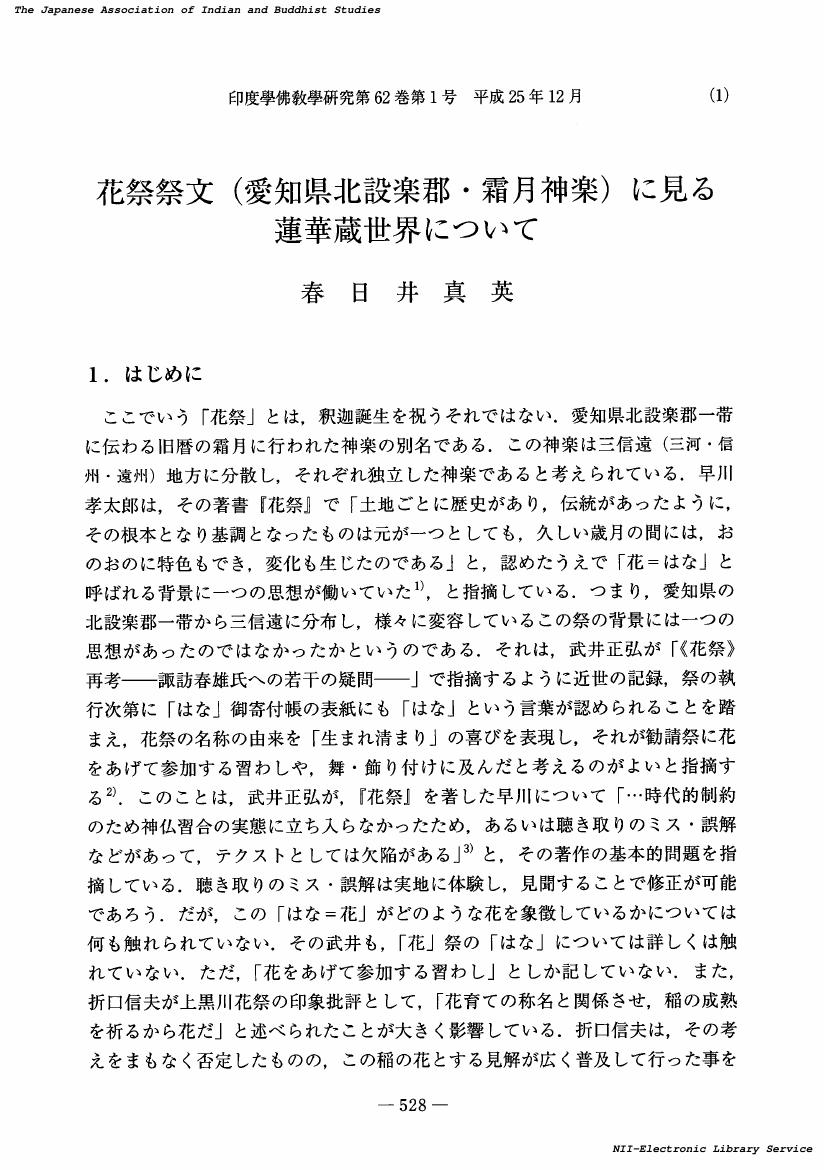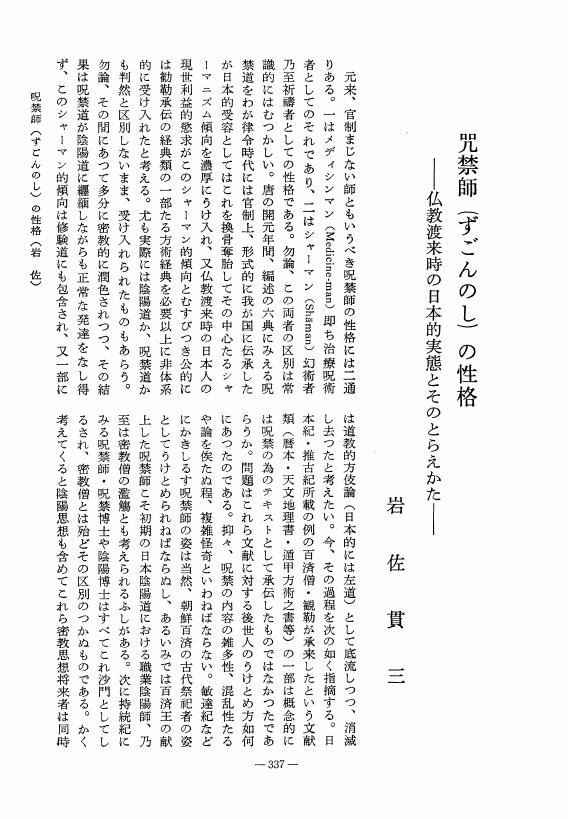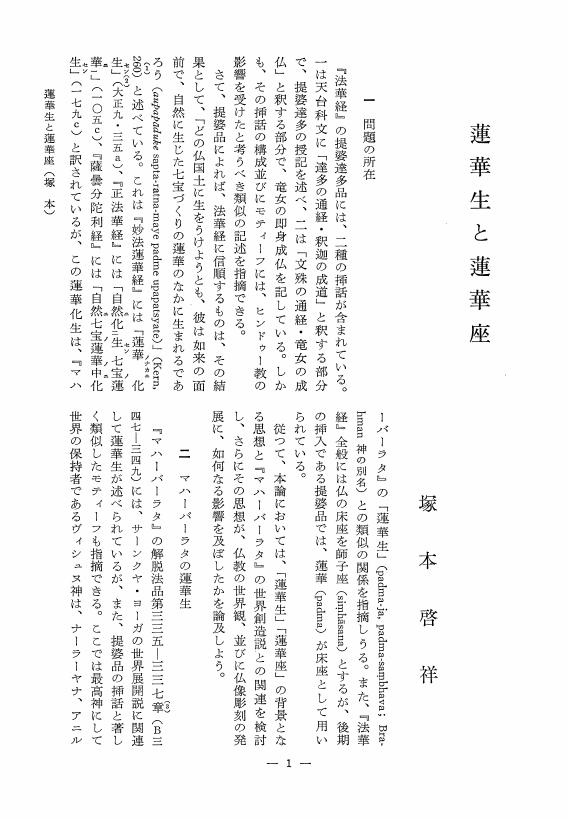1 0 0 0 OA 花祭祭文(愛知県北設楽郡・霜月神楽)に見る蓮華蔵世界について
- 著者
- 春日井 真英
- 出版者
- 日本印度学仏教学会
- 雑誌
- 印度學佛教學研究 (ISSN:00194344)
- 巻号頁・発行日
- vol.62, no.1, pp.528-521, 2013-12-20 (Released:2017-09-01)
1 0 0 0 ジャイナ教チャリタ文学における主要人物の変遷とその背景
- 著者
- 山畑 倫志
- 出版者
- 日本印度学仏教学会
- 雑誌
- 印度學佛教學研究 (ISSN:00194344)
- 巻号頁・発行日
- vol.68, no.1, pp.522-516, 2019
<p>Jain Carita Literature has a long tradition. The Jains had formalized their saints into Sixty-three Great Men. However, the authors of Carita works often created many biographies about saints other than the Sixty-three Great Men. This paper takes up three people, Neminātha, Bāhubalin, and Śālibhadra.</p><p>Neminātha, the 22nd Tīrthaṅkara is included in Sixth-three Great Men. But the Jain Old Gujarati works, succeeding a tradition of the Jain Caritas, emphasized the love of his fiance Rājul for Neminātha, rather than the biography of Neminātha.</p><p>Bāhubalin overwhelmed his brother, the first Cakravartin Bharata, in a battle, and underwent a conversion to Jain doctrine by his father, the first Tīrthaṅkara, Ṛṣabha. Bāhubalin is the most important character in that story.</p><p>Śālibhadra was a very wealthy merchant whose wealth outdid that of the king. But one day he realized that the king dominated him, and all people also had a master. Then Śālibhadra renounced the worldly life.</p><p>This paper proposes that the Jain authors gave these Extra-saints appropriate roles required according to the social or political situation.</p>
1 0 0 0 OA 世親の漫談――『釈軌論』にみられる説法者――
- 著者
- 上野 牧生
- 出版者
- 日本印度学仏教学会
- 雑誌
- 印度學佛教學研究 (ISSN:00194344)
- 巻号頁・発行日
- vol.69, no.3, pp.1072-1078, 2021-03-25 (Released:2021-09-06)
- 参考文献数
- 3
- 被引用文献数
- 1
世親作『釈軌論』(Vyākhyāyukti)の掉尾を飾る第5章では,説法者(dhārmakathika)の予備軍に向けて,説法の見本が示される.特にその第3節では,奇譚・漫談・厭世譚の実例が紹介される.それぞれ,聴き手を驚かせる・笑わせる・〔輪廻や欲望や怠惰を〕厭わせることを目的とする小話である(この3点が布教の契機として重視される).それらはいずれも簡潔で短く,任意の引用,そして説法での実用に適する.おそらくは説法の前に,あるいはその合間に,説法者の声に耳を傾けない相手に向けて語られるものであろう.本稿はそのなか,居眠りする聴衆を笑わせ,眠りを醒ます目的で語られる漫談の全話を紹介する.例えば,次のような小話である.「ある外教徒がマハーバーラタを読んで泣いていると,ある人から「なぜ泣いているのですか?」と聞かれた.「シーターがどれほどの苦しみを味わったかご覧になりましたか」と答えると,「それはマハーバーラタですよ,ラーマーヤナではありませんよ」と言われた.外教徒は「私が泣いたのは無意味でしたね」と虚しく語った.これと同じように,説法者の語る佛陀のことばも,注意して聴かなければ無意味なのです」と.往時の説法者は,こうした漫談で聴衆の笑いをとり,あるいは,話を滑らせ失笑を買ったであろうか.『釈軌論』から推測する限り,少なくとも世親自身が説法者であった,とはいえそうである.とはいえ,世親が居眠りする者にまで気を配る様は驚きでもある.あまつさえ,喜劇的な話や下世話な話,自虐までを漫談に織り込み,時には聴き手に合いの手を求めている.そうまでして世親が人々を佛教の聴聞に導こうとするのは,そこまで考慮しなければ,人々が佛教に耳を傾けなくなった当時・当地の時代状況を反映しているのかもしれない.いずれにせよ,『釈軌論』第5章の記述は,5世紀前後の説一切有部圏域における説法者の実態の,その一端を記したものとして注目に値する.
1 0 0 0 OA 『法華経集験記』に関する一考察
- 著者
- 髙平 妙心
- 出版者
- 日本印度学仏教学会
- 雑誌
- 印度學佛教學研究 (ISSN:00194344)
- 巻号頁・発行日
- vol.56, no.2, pp.668-671, 2008-03-20 (Released:2017-09-01)
1 0 0 0 一向上人と踊躍念佛
- 著者
- 伊藤 眞徹
- 出版者
- 日本印度学仏教学会
- 雑誌
- 印度學佛教學研究 (ISSN:00194344)
- 巻号頁・発行日
- vol.12, no.2, pp.706-709, 1964
1 0 0 0 OA 日蓮の用いた勘文 (かんもん) の義について
- 著者
- 岩佐 貫三
- 出版者
- Japanese Association of Indian and Buddhist Studies
- 雑誌
- 印度學佛教學研究 (ISSN:00194344)
- 巻号頁・発行日
- vol.20, no.1, pp.266-269, 1971-12-31 (Released:2010-03-09)
1 0 0 0 OA ラーマーヌジャ生誕の伝記について
- 著者
- 澤井 義次
- 出版者
- Japanese Association of Indian and Buddhist Studies
- 雑誌
- 印度學佛教學研究 (ISSN:00194344)
- 巻号頁・発行日
- vol.39, no.1, pp.475-471, 1990-12-20 (Released:2010-03-09)
1 0 0 0 井上哲次郎の開拓者的意義
- 著者
- 今西 順吉
- 出版者
- 日本印度学仏教学会
- 雑誌
- 印度學佛教學研究 (ISSN:00194344)
- 巻号頁・発行日
- vol.49, no.2, pp.526-532, 2001
- 著者
- 藤吉 慈海
- 出版者
- Japanese Association of Indian and Buddhist Studies
- 雑誌
- 印度學佛教學研究 (ISSN:00194344)
- 巻号頁・発行日
- vol.11, no.1, pp.142-143, 1963-01-15 (Released:2010-03-09)
1 0 0 0 OA 咒禁師 (ずごんのし) の性格 -仏教渡来時の日本的実態とそのとらえかた-
- 著者
- 岩佐 貫三
- 出版者
- Japanese Association of Indian and Buddhist Studies
- 雑誌
- 印度學佛教學研究 (ISSN:00194344)
- 巻号頁・発行日
- vol.18, no.1, pp.337-340, 1969-12-25 (Released:2010-03-09)
- 参考文献数
- 3
1 0 0 0 OA 五十二位の菩薩階位説の成立について
- 著者
- 水野 荘平
- 出版者
- 日本印度学仏教学会
- 雑誌
- 印度學佛教學研究 (ISSN:00194344)
- 巻号頁・発行日
- vol.57, no.2, pp.775-780, 2009-03-20 (Released:2017-09-01)
- 著者
- 田中 公明
- 出版者
- JAPANESE ASSOCIATION OF INDIAN AND BUDDHIST STUDIES
- 雑誌
- 印度學佛教學研究 (ISSN:00194344)
- 巻号頁・発行日
- vol.46, no.2, pp.913-909, 1998
1 0 0 0 OA 蓮華生と蓮華座
- 著者
- 塚本 啓祥
- 出版者
- Japanese Association of Indian and Buddhist Studies
- 雑誌
- 印度學佛教學研究 (ISSN:00194344)
- 巻号頁・発行日
- vol.28, no.1, pp.1-9, 1979-12-31 (Released:2010-03-09)
1 0 0 0 OA 親鸞の非僧非俗に就いて
- 著者
- 佐々木 徹眞
- 出版者
- Japanese Association of Indian and Buddhist Studies
- 雑誌
- 印度學佛教學研究 (ISSN:00194344)
- 巻号頁・発行日
- vol.4, no.1, pp.152-153, 1956-01-30 (Released:2010-03-09)
1 0 0 0 蕪村の浄土信仰
- 著者
- 宮沢 正順
- 出版者
- 日本印度学仏教学会
- 雑誌
- 印度學佛教學研究 (ISSN:00194344)
- 巻号頁・発行日
- vol.18, no.1, pp.303-307, 1969
1 0 0 0 沢庵『太阿記』における思想とその影響について
- 著者
- 笠井 哲
- 出版者
- 日本印度学仏教学会
- 雑誌
- 印度學佛教學研究 (ISSN:00194344)
- 巻号頁・発行日
- vol.61, no.2, pp.533-538, 2013
1 0 0 0 OA 仏教における三明 (tisso vijja) の成立
- 著者
- 榎本 文雄
- 出版者
- Japanese Association of Indian and Buddhist Studies
- 雑誌
- 印度學佛教學研究 (ISSN:00194344)
- 巻号頁・発行日
- vol.29, no.2, pp.939-936, 1981-03-31 (Released:2010-03-09)
- 著者
- 市川 白弦
- 出版者
- Japanese Association of Indian and Buddhist Studies
- 雑誌
- 印度學佛教學研究 (ISSN:00194344)
- 巻号頁・発行日
- vol.11, no.1, pp.359-348, 1963-01-15 (Released:2010-03-09)
1 0 0 0 OA 中有の機能について
- 著者
- 池田 練太郎
- 出版者
- Japanese Association of Indian and Buddhist Studies
- 雑誌
- 印度學佛教學研究 (ISSN:00194344)
- 巻号頁・発行日
- vol.39, no.2, pp.926-922, 1991-03-20 (Released:2010-03-09)
- 被引用文献数
- 1 4
1 0 0 0 血脈不断・相続也大難――宋代禅宗における公案解釈の一視点――
- 著者
- 土屋 太祐
- 出版者
- 日本印度学仏教学会
- 雑誌
- 印度學佛教學研究 (ISSN:00194344)
- 巻号頁・発行日
- vol.67, no.2, pp.777-783, 2019
<p>The phrases "it is difficult to continue" (相続也大難) and "the blood lineage is not interrupted" (血脈不断) are found in the <i>Biyan lu</i> 碧巌録, one of the most important works of <i>gong'an</i> Chan 公案禅 during the Song dynasty. These phrases came from the sayings of two patriarchs of the Cao-Dong 曹洞 lineage, Dongshan Liangjie 洞山良价 and Caoshan Benji 曹山本寂. There is a possibility that these phrases had been passed down in the traditions of the Cao-Dong lineage. These phrases show that, when interpreting <i>gong'an</i>, the <i>Biyan lu</i> had a tendency to show an appreciation of monks changing their positions constantly and developing questions and answers without interruption. In this interpretative perspective, emphasis is placed on skillfully preserving the flow of dialogue, and individual phrases of a <i>gong'an</i> are not interpreted on the basis of their inherent meaning. This is one of the reasons that the <i>Biyan lu</i> is difficult to understand.</p>











